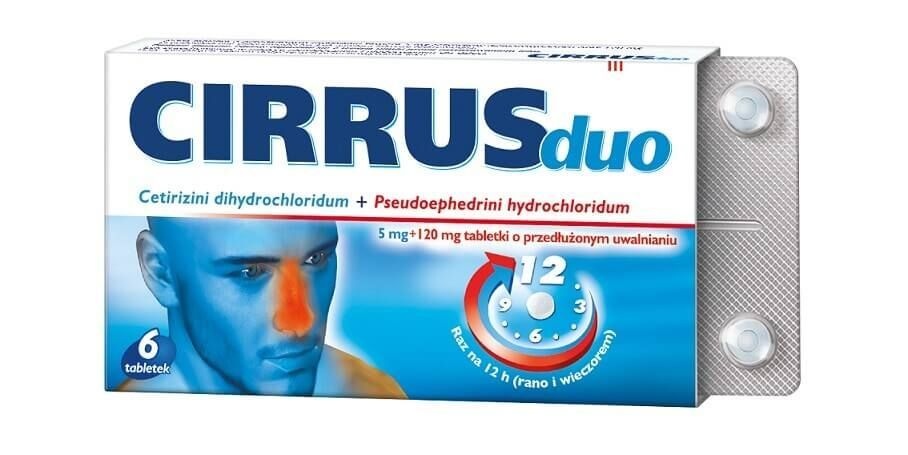

Cirrus

Ask a doctor about a prescription for Cirrus

How to use Cirrus
Package Leaflet: Information for the Patient
Cirrus, 5 mg + 120 mg, Prolonged-Release Tablets
Cetirizine Dihydrochloride + Pseudoephedrine Hydrochloride
Read the package leaflet carefully before taking the medicine, as it contains important information for the patient.
- Keep this leaflet, so you can read it again if you need to.
- If you have any doubts, consult your doctor or pharmacist.
- This medicine has been prescribed specifically for you. Do not pass it on to others. The medicine may harm another person, even if their symptoms are the same as yours.
- If you experience any side effects, including those not listed in this leaflet, tell your doctor or pharmacist. See section 4.
Table of Contents of the Leaflet
- 1. What is Cirrus and what is it used for
- 2. Important information before taking Cirrus
- 3. How to take Cirrus
- 4. Possible side effects
- 5. How to store Cirrus
- 6. Contents of the pack and other information
1. What is Cirrus and what is it used for
Cirrus contains two active substances: cetirizine dihydrochloride and pseudoephedrine hydrochloride. Cetirizine dihydrochloride is an antiallergic medicine, while pseudoephedrine hydrochloride narrows the blood vessels in the nasal mucosa, reducing nasal congestion.
Cirrus, prolonged-release tablets, is indicated for the treatment of symptoms of seasonal and perennial allergic rhinitis, such as: nasal congestion, sneezing, runny nose, and itching of the nose and eyes. The medicine is intended for use in cases where both antiallergic and decongestant effects are desired.
2. Important information before taking Cirrus
When not to take Cirrus:
- if you are allergic to the active substances, ephedrine, piperazine, or its derivatives, or any of the other ingredients of this medicine (listed in section 6),
- if you have very high blood pressure (severe hypertension) or uncontrolled hypertension, or severe coronary heart disease,
- if you have severe acute (sudden) or chronic (long-term) kidney disease, or kidney failure / end-stage kidney failure,
- if you have uncontrolled hyperthyroidism,
- if you have severe heart rhythm disorders,
- if you have been diagnosed with a pheochromocytoma (a tumor of the adrenal gland),
- if you have been diagnosed with glaucoma or increased intraocular pressure,
- if you have urinary retention,
- if you have had a stroke,
- if you are at high risk of hemorrhagic stroke,
- if you are taking dihydroergotamine (a medicine used for migraine),
- if you are currently taking or have taken within the last two weeks monoamine oxidase inhibitors (MAOIs), see below "Cirrus and other medicines",
- in children under 12 years of age.
Warnings and precautions
Before taking Cirrus, discuss it with your doctor or pharmacist.
Be particularly careful when taking Cirrus if:
- you have diabetes,
- you have hyperthyroidism,
- you have hypertension (high blood pressure), especially if you are also taking non-steroidal anti-inflammatory drugs (NSAIDs),
- you have coronary heart disease or heart rhythm disorders, such as tachycardia,
- you have moderate kidney or liver failure (see section 3),
- you are elderly,
- you are taking sympathomimetic medicines (such as decongestants, appetite suppressants, psychostimulants, e.g., amphetamine and its derivatives), tricyclic antidepressants, antihypertensive medicines, alcohol, or medicines that impair central nervous system function and reduce performance, cardiac glycosides such as digoxin or digitoxin (see below "Cirrus and other medicines"),
- you have prostate enlargement or difficulty urinating,
- you have risk factors for hemorrhagic stroke (such as concomitant use of other vasoconstrictor medicines, e.g., bromocriptine, pergolide, lisuride, cabergoline, ergotamine, or any other decongestant medicine), as vasoconstriction and increased blood pressure increase the risk of hemorrhagic stroke,
- you have a risk of hypercoagulable states, e.g., in inflammatory bowel disease,
- you have conditions where anticholinergic effects are undesirable, particularly in patients with risk factors for urinary retention (e.g., spinal cord injuries, prostate enlargement, or bladder outlet obstruction), as Cirrus may increase the risk of urinary retention,
If you experience a fever with generalized redness of the skin and a pustular rash, stop taking Cirrus and contact your doctor or seek medical attention immediately. See section 4.
During treatment with Cirrus, sudden abdominal pain or rectal bleeding may occur due to ischemic colitis. If you experience such gastrointestinal symptoms, stop taking Cirrus and seek medical attention immediately. See section 4.
After taking pseudoephedrine-containing medicines, cases of posterior reversible encephalopathy syndrome (PRES) and reversible cerebral vasoconstriction syndrome (RCVS) have been reported. PRES and RCVS are rare conditions that may be associated with reduced blood flow to the brain.
If you experience symptoms that may be signs of PRES or RCVS, stop taking Cirrus immediately and seek medical attention (symptoms, see section 4 "Possible side effects").
Be cautious in patients with hypertension who are taking NSAIDs, as both NSAIDs and pseudoephedrine can increase blood pressure.
Before taking Cirrus, consult your doctor, even if the above warnings and precautions refer to a past situation.
Cirrus may affect the results of allergic skin tests. Therefore, skin tests should be performed after a 3-day washout period.
There have been reports of pseudoephedrine abuse, similar to other centrally acting stimulants.
When pseudoephedrine is used by athletes, it should be noted that its use may result in a positive doping test.
Using Cirrus in patients with renal impairment
Be particularly careful when taking Cirrus in patients with kidney failure. In patients with moderate kidney failure, the dose of Cirrus should be reduced to one tablet per day. In patients with end-stage kidney failure, Cirrus should not be used. Consult your doctor before taking the medicine.
Using Cirrus in patients with hepatic impairment
Be particularly careful when taking Cirrus in patients with liver failure. In patients with moderate liver failure, the dose of Cirrus should be reduced to one tablet per day. Consult your doctor before taking the medicine.
Children and adolescents
Cirrus should not be used in children under 12 years of age (see above "When not to take Cirrus"), as the combination of active substances in Cirrus has not been studied in this age group and due to the presence of pseudoephedrine.
Cirrus and other medicines
Tell your doctor or pharmacist about all medicines you are taking, have recently taken, or might take. Some medicines, when taken with Cirrus, may cause side effects.
Do not take Cirrus with the following medicines:
- monoamine oxidase inhibitors (used in depression). When taken with Cirrus, they may cause increased blood pressure and even a hypertensive crisis. This side effect is possible within two weeks after stopping these medicines, so do not take Cirrus during treatment with monoamine oxidase inhibitors and for two weeks after their discontinuation.
- dihydroergotamine (used in migraine), see above "When not to take Cirrus".
Before taking Cirrus, consult your doctor if you are taking any of the following medicines:
- linezolid (an antibiotic),
- tricyclic antidepressants, such as imipramine, amitriptyline, doxepin,
- vasoconstrictor medicines, such as bromocriptine, pergolide, lisuride, cabergoline, ergotamine,
- nasal decongestants, such as phenylpropanolamine, phenylephrine, ephedrine,
- appetite suppressants, such as phentermine, mazindol,
- psychostimulants, such as amphetamine and its derivatives,
- antihypertensive medicines, such as methyldopa, guanethidine, and reserpine, and beta-adrenergic blocking agents (e.g., atenolol, bisoprolol). Cirrus may reduce the effect of these medicines.
- cardiac glycosides, such as digoxin or digitoxin, used in heart failure,
- central nervous system depressants, such as sedatives,
- antacids (containing, e.g., aluminum or magnesium hydroxide) and proton pump inhibitors (used in the treatment of peptic ulcer disease, such as omeprazole). Note that these medicines increase the absorption of pseudoephedrine.
- halogenated general anesthetics, such as halothane,
- kaolin (used in diarrhea) reduces the absorption of pseudoephedrine,
- theophylline (used in asthma),
- ritonavir (used in HIV infection).
Be cautious when taking Cirrus in patients with hypertension who are also taking NSAIDs, such as acetylsalicylic acid, paracetamol, ibuprofen, naproxen.
During treatment with Cirrus, a decrease in blood flow to the optic nerve may occur. If sudden vision loss occurs, stop taking Cirrus and seek medical attention immediately. See section 4.
Using Cirrus with food and drink
Cirrus can be taken with or without food.
Pregnancy, breastfeeding, and fertility
If you are pregnant or breastfeeding, think you may be pregnant, or plan to have a baby, consult your doctor or pharmacist before taking this medicine.
Cirrus should not be used during pregnancy.
Cirrus should not be used during breastfeeding, as cetirizine and pseudoephedrine pass into breast milk.
Studies in rats have not shown any effect on fertility. There are no data on the effect of Cirrus on human fertility.
Driving and using machines
In studies, cetirizine has not been shown to have a significant effect on driving ability or psychophysical performance at recommended doses. However, some people taking part in the studies experienced drowsiness. Cetirizine at higher-than-recommended doses may affect the central nervous system. Concomitant use of cetirizine with alcohol or other substances that depress the central nervous system may further impair reaction time and concentration. However, no negative effect of pseudoephedrine is expected.
Therefore, patients who drive vehicles, perform potentially hazardous activities, or operate machinery should be cautious, not exceed the recommended dose, and take into account their individual response to the medicine and the possibility of side effects. Patients should not drive if they experience drowsiness or dizziness.
Cirrus contains lactose and sodium
If you have been diagnosed with an intolerance to some sugars, consult your doctor before taking the medicine.
The medicine contains less than 1 mmol (23 mg) of sodium per tablet, which means it is essentially "sodium-free".
3. How to take Cirrus
Always take this medicine exactly as your doctor or pharmacist has told you. If you are not sure, consult your doctor or pharmacist.
The recommended dose of Cirrus for adults is one tablet twice a day (morning and evening) with or without food.
Cirrus tablets should not be broken, chewed, crushed, or split. Swallow the medicine whole with a sufficient amount of liquid.
Duration of treatment
The treatment period with Cirrus should not exceed the duration of symptoms and should not be longer than 2 to 3 weeks. Your doctor may recommend continued treatment with cetirizine alone.
Using Cirrus in patients with moderate kidney or liver failure
In patients with moderate kidney or liver failure, the dose of Cirrus should be reduced by half (to 1 tablet per day).
Using Cirrus in children and adolescents
Adolescents (12 to 18 years): one tablet twice a day (morning and evening), with or without food.
Children under 12 years: Cirrus is contraindicated (see above "When not to take Cirrus" and "Children and adolescents").
If you feel that the effect of Cirrus is too strong or too weak, consult your doctor.
Taking a higher dose of Cirrus than recommended
If you have taken more than the recommended dose (overdose), seek medical attention immediately.
Symptoms of acute overdose of Cirrus include: diarrhea, dizziness, fatigue, headache, malaise, dilated pupils, urinary retention, rapid heartbeat, arrhythmias, increased blood pressure, sedation, apnea, loss of consciousness, cyanosis, and cardiovascular collapse. These symptoms can be life-threatening. Significant overdose of Cirrus may cause toxic psychosis with delusions and hallucinations. In some patients, arrhythmias, cardiovascular collapse, seizures, coma, and respiratory failure may occur. These symptoms can lead to death.
Treatment of overdose (symptomatic and supportive) should be carried out in a hospital setting. Note that hemodialysis removes cetirizine and pseudoephedrine from the body only to a small extent.
Missing a dose of Cirrus
Do not take a double dose to make up for a missed dose.
After stopping treatment, itching may occur (rarely).
If you have any further doubts about taking this medicine, consult your doctor or pharmacist.
4. Possible side effects
Like all medicines, Cirrus can cause side effects, although not everybody gets them.
Stop taking Cirrus immediately and seek medical attention if you experience symptoms that may be signs of posterior reversible encephalopathy syndrome (PRES) and reversible cerebral vasoconstriction syndrome (RCVS). These include:
- severe headache with sudden onset,
- nausea,
- vomiting,
- confusion,
- seizures,
- vision changes.
Frequent side effects (may affect up to 1 in 10 people):
- nervousness
- insomnia
- dizziness, headache
- drowsiness
- rapid heartbeat
- dry mouth
- nausea
- weakness
Uncommon side effects (may affect up to 1 in 100 people):
- restlessness
- excitement
Rare side effects (may affect up to 1 in 1,000 people):
- allergic reactions (including anaphylactic shock)
- hallucinations
- seizures, tremors
- arrhythmias
- pallor
- high blood pressure
- vomiting
- liver function disorders (increased transaminase activity, alkaline phosphatase, gamma-glutamyltransferase, increased bilirubin levels)
- dry skin, rash, increased sweating, urticaria
- painful or difficult urination
Very rare side effects (may affect less than 1 in 1,000 people):
- psychotic disorders
- taste disorders
- cerebrovascular incidents (stroke)
- ischemic colitis
- drug rash
- cardiovascular collapse (sudden decrease in blood pressure, severe weakness, pallor, increased sweating, often with loss of consciousness)
- angioedema (swelling of the face, eyelids, mucous membranes, lips, tongue, and larynx, causing difficulty breathing and swallowing). If you experience any of these symptoms, inform your doctor immediately or go to the nearest hospital
Frequency not known (frequency cannot be estimated from available data):
- severe vascular disorders affecting the brain, known as posterior reversible encephalopathy syndrome (PRES) and reversible cerebral vasoconstriction syndrome (RCVS)
- aggression, confusion, depressed mood (depression), involuntary movements (tics), euphoria, suicidal thoughts
- skin sensation disorders (paresthesia), inability to sit still, calm down, or rest (psychomotor restlessness), abnormal, prolonged muscle contractions (dystonia), involuntary movements (dyskinesia), memory loss (amnesia), memory problems, fainting
- accommodation disorders (eye disorders), blurred vision, abnormal pupil dilation, eye pain, vision loss, involuntary eye movements, abnormal light tolerance
- breathing difficulties (dyspnea)
- erectile dysfunction
- sudden fever, skin redness, or numerous small pustules (possible symptoms of acute generalized exanthematous pustulosis - AGEP) may occur within the first 2 days of taking Cirrus. See section 2. If you experience such symptoms, stop taking Cirrus and contact your doctor or seek medical attention immediately
- itching
- palpitations, myocardial infarction, low blood pressure (hypotension)
- diarrhea, abdominal discomfort
- reduced blood flow to the optic nerve (ischemic optic neuropathy)
- urinary retention, incontinence
- joint pain, muscle pain
- edema, malaise
When taking cetirizine alone, isolated cases of hepatitis have been reported.
In some people, other side effects may occur when taking Cirrus.
Reporting side effects
If you experience any side effects, including those not listed in this leaflet, tell your doctor or pharmacist. Side effects can be reported directly to the Department of Drug Safety Monitoring of the Office for Registration of Medicinal Products, Medical Devices, and Biocidal Products: Al. Jerozolimskie 181 C, 02-222 Warsaw, tel.: +48 22 49 21 301, fax: +48 22 49 21 309, website: https://smz.ezdrowie.gov.pl. Side effects can also be reported to the marketing authorization holder. By reporting side effects, you can help provide more information on the safety of this medicine.
5. How to store Cirrus
Keep the medicine out of the sight and reach of children.
Do not use this medicine after the expiry date stated on the carton. The expiry date refers to the last day of the month.
There are no special storage precautions for the medicine.
Medicines should not be disposed of via wastewater or household waste. Ask your pharmacist how to dispose of medicines no longer required. This will help protect the environment.
6. Contents of the pack and other information
What Cirrus contains
- The active substances of Cirrus are cetirizine dihydrochloride and pseudoephedrine hydrochloride. Each tablet contains 5 mg of cetirizine dihydrochloride in the form of immediate release and 120 mg of pseudoephedrine hydrochloride in the form of prolonged release.
- The other ingredients are: The immediate-release layer contains: lactose monohydrate, microcrystalline cellulose, sodium croscarmellose, colloidal anhydrous silica, magnesium stearate. The prolonged-release layer contains: hypromellose, microcrystalline cellulose, colloidal anhydrous silica, magnesium stearate. The Opadry Y-1-7000 white coating contains: hypromellose, titanium dioxide (E171), and macrogol 400.
What Cirrus looks like and contents of the pack
Cirrus is a white or almost white, round, biconvex tablet.
The pack contains 14 tablets.
PVC-Aclar/Rx160/Al blister in a cardboard box.
Marketing authorization holder and manufacturer
Marketing authorization holder:
VEDIM Sp. z o.o.
ul. Kruczkowskiego 8
00-380 Warsaw
Tel. +48 22 696 99 20
Manufacturer:
Aesica Pharmaceuticals S.r.l.
Via Praglia 15
I-10044 Pianezza (TO), Italy
Importer:
PHOENIX Pharma Polska Sp. z o.o.
ul. Rajdowa 9, Konotopa
05-850 Ożarów Mazowiecki
Date of last revision of the leaflet: March 2024
- Country of registration
- Active substance
- Prescription requiredYes
- Manufacturer
- ImporterAesica Pharmaceuticals S.r.l. PHOENIX Pharma Polska Sp. z o.o.
- This information is for reference only and does not constitute medical advice. Always consult a licensed doctor before taking any medication. Oladoctor is not responsible for medical decisions based on this content.
- Alternatives to CirrusDosage form: Syrup, (1.25 mg + 30 mg + 10 mg)/5 mlActive substance: pseudoephedrine, combinationsPrescription not requiredDosage form: Syrup, (1.25 mg + 30 mg + 10 mg)/5 mlActive substance: pseudoephedrine, combinationsManufacturer: Delpharm OrleansPrescription not requiredDosage form: Tablets, 5 mg + 120 mgActive substance: pseudoephedrine, combinationsManufacturer: PHOENIX Pharma Polska Sp. z o.o. UCB Pharma S.p.A.Prescription not required
Alternatives to Cirrus in other countries
The best alternatives with the same active ingredient and therapeutic effect.
Alternative to Cirrus in Spain
Alternative to Cirrus in Ukraine
Online doctors for Cirrus
Discuss dosage, side effects, interactions, contraindications, and prescription renewal for Cirrus – subject to medical assessment and local rules.








